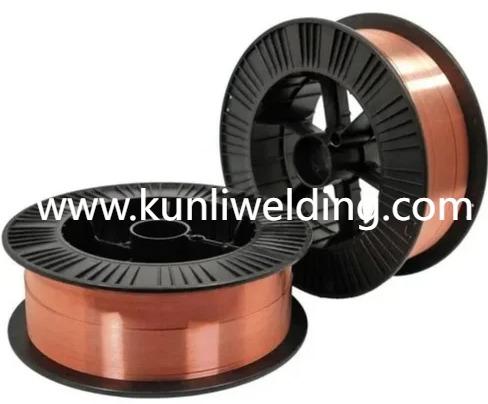Can changing ER5087 wire diameter improve feed reliability in corrosion zones

When a project calls for a dependable filler in corrosive or high stress environments, selecting the correct wire diameter is a small decision with outsized operational impact. Aluminum Welding Wire ER5087 is often specified for its balance of strength and corrosion resistance in marine and industrial settings, but getting predictable feed and weld quality depends on choosing a diameter that fits the machine, the joint, and the production rhythm.
Start by matching the wire to the feeding system. Drive rolls, liners, and spool adapters all have preferred ranges. A thinner diameter can be easier to bend through tight liners and small feeder paths, but it may require more frequent spool changes and deliver lower deposition per pass. A thicker diameter raises deposition and shortens cycle time for larger seams, yet needs a drive and liner that prevent bird nesting and kinks. Check your machine manual and your typical spool geometry, then plan a bench feed test that reproduces the actual feed path the coil will follow.
Consider joint geometry and accessibility. When working on confined repairs or thin sheet assemblies, a smaller wire often reduces burn through risk and gives finer puddle control for visible seams. For thicker plates and longer runs, larger diameters maintain travel speed and reduce the number of passes required. If your program mixes small and large jobs, maintain a simple kit of liner sizes and adapters so crews can switch diameters without lengthy changeover delays.
Arc behavior and puddle control shift with diameter. Thinner wire tends to create a slightly narrower bead and responds faster to travel speed changes, which benefits delicate fit up. Heavier wire supports a fuller puddle and handles gaps by depositing filler more quickly. When teams test diameters in the shop, photograph the pilot bead and note travel speed and stick out. Those photos become the reference when a different operator repeats the joint on another shift.
Feeder maintenance and spare parts are practical enablers. Aluminum wire feed benefits from clean liners and matched drive roll grooves. Keep routine checks on drive roll wear and have spare liners suited to each diameter you run. A short pre shift checklist that includes a bench feed run and a look for feed chatter catches most problems before a full weld sequence begins. These modest habits prevent a small diameter choice from turning into a major production interruption.
Environmental and handling factors matter more than many engineers expect. Coils that get moisture or abrasive damage in transit can behave unpredictably regardless of diameter. Inspect spool wraps and outer flanges on arrival, then run a short feed test in the exact feeder geometry you will use. If the feed test shows hesitation or bird nesting, address liner, drive roll, or spool orientation rather than assuming diameter alone is at fault.
Process selection interacts with diameter choice. For MIG applications where throughput is essential choose a diameter that provides the deposition rate you need without overtaxing the feeder. For TIG with push wire feeders consider a diameter that feeds smoothly while still allowing precise manual control. In both processes set a pilot routine that captures the chosen power settings, shielding gas notes, and the visual appearance of the weld so future spools can be run to the same standard.
Pilot testing is essential. A concise script that includes spool marking verification, a bench feed test through the real feed path, and a sample weld under production like travel speed provides the evidence you need to standardize a diameter choice. Store the pilot photo with the spool marking and parameter notes so repeat orders use the same starting point and qualification is faster.
Operator technique and short training sessions preserve consistency. A small difference in stick out or torch angle between operators can change bead shape more than diameter does. Regular briefings on feed checks, torch posture and gas verification help teams get repeatable outcomes across shifts and reduce the weight of diameter choice on final quality.
Look to supplier guidance for a head start. Manufacturers often publish handling notes and recommendations that map diameters to common feeder types and joint styles. When procurement and engineering include a pilot clause, suppliers are more likely to share practical setup parameters and packaging specs that keep the coil in production ready condition. Those notes shorten qualification and reduce the number of trial spools you need before full acceptance.
Finally, think about logistics in your shop rhythm. If switchover time is a bottleneck choose diameters that align with your most frequent joint types and minimize changes. If the work is repair heavy and access limited favor a smaller diameter that supports better control. When production favors long seams choose a larger diameter that supports throughput without feeding headaches.
If you are preparing a pilot, collect supplier handling notes, run a bench feed test in your exact feeder geometry, perform a short production like weld, and archive photos with the spool marking. Those practical steps make diameter choice a predictable operational setting rather than a recurring negotiation. For product information and practical notes relevant to ER5087 see the technical material and application guidance available from suppliers such as Kunliwelding which can help you design an effective pilot program and pick the diameter that fits your machine and workflow.
- Art
- Causes
- Crafts
- Dance
- Drinks
- Film
- Fitness
- Food
- Games
- Gardening
- Health
- Home
- Literature
- Music
- Networking
- Other
- Party
- Religion
- Shopping
- Sports
- Theater
- Wellness


